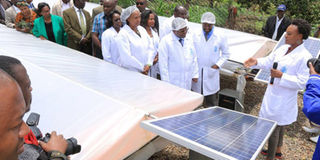Sweet fruits of value addition

Dr Catherine Kunyanga, a food scientist at the University of Nairobi explains a point on how the tunnel solar dryer works at the upgraded and modernised Karurumo Self-Help Group fruit processing plant in Embu. PHOTO | COURTESY
What you need to know:
- For good manufacturing practices, processing must comply with all food safety.
- The new facility consists of a cold storage room which acts as an aggregation centre, solar dryer and electricity powered fruit processing line.
- For good manufacturing practices, processing must comply with all food safety regulations so that their nutrients aren’t damaged in the process.
- Value addition and produce processing, are key aspects in reducing postharvest losses in the country and hence boosting its food security.
The building at the outskirts of Karurumo Shopping Centre in Runyenjes, Embu County, looks forlorn, but it is a hub of value addition.
Sitting on three-quarter-acre, the building belongs to Karurumo Horticulture Self-help Group, which processes mainly mangoes into various products.
Alloys Mbogo, the 15-member group’s chairperson, notes that Embu County has up to 400,000 mango fruit trees, with December to April being the peak season.
But lack of proper storage or processing facilities means that tonnes of the fruits rot on the farm.
About 50 per cent of mangoes produced in the county go to waste every season, according to researchers.
Erick Ndwiga, a group member, owns more than 500 mango trees of the Kent, Tommy Atkins and Van Dyke varieties.
He initially sold his mangoes through brokers, but the processing project has now provided him with ready market.
Determined to overcome exploitation, members of Karurumo Self-Help Group started processing their fruits at a member’s house, until 2015 after acquiring value addition skills following training by German organisation, GIZ, which was working with farmers in the region.
They began buying fruits from farmers at between Sh10-15 for a kilo of mangoes, Sh11 for a kilo of bananas, Sh20-25 for a kilo of butternuts, and Sh30-35 for a kilo of pumpkins.
The group was established in 2003, with 53 members, however only 15 of the members are still active while the rest are ‘seasonal’.
“We, thereafter, bought land at Sh450,000, built a solar dryer at Sh500,000 and established the other structures at a total cost of Sh2 million, the money which came from members contributions and a loan from a bank,” says Mbogo.
They further acquired the Kenya Bureau of Standards (KEBS) certification for their products which included Pedo Juice, Pedo jam, Pumpkin flour and moringa flour.
A litre of unprocessed pulp went for Sh200, the juices go for a similar price as the market price of other juices, 500 grams of jam goes for Sh200-250.
Before the processing begins, the fruits are peeled then sliced into smaller pieces. They are then put in the pulping machine for pulping after which the pulp is pasteurised.
GOOD MANUFACTURING PRACTICES
It is then cooled to the required temperature then packaged for sale as unprocessed pulp or further processed into other products.
However, to make the juice, the pulp is mixed with other ingredients such as sugar, water and preservatives in the right ratios depending on the type of product then, package.

Group members pack processed juice at the fruit processing plant in Embu. Before the processing begins, the fruits are peeled then sliced into smaller pieces then put in the pulping machine for pulping after which the pulp is pasteurised. PHOTO | COURTESY
The group had their facility recently upgraded by University of Nairobi Postharvest Project team supported by the Rockefeller Foundation under the YieldWise Program on Postharvest Loss Reduction.
The project is being implemented in collaboration with Jomo Kenyatta University of Science and Technology (JKUAT), and TechnoServe Kenya at a cost of KSH 20 million.
The upgraded facility, the Karurumo Smallholder Aggregation and Processing centre is endowed with cold storage facilities for aggregation of their produce in addition to wet-processing and dry processing facilities.
Emmanuel Amwoka the project assistant who is also an MSC Horticulture student at University of Nairobi, says that the goal of the project is to help the farmers to process diverse fruit and vegetable products that meet KEBS standards so that they can access domestic and export market.
“We also plan to work with the Export Promotion Council to explore possibilities of exporting dried fruits,” notes Mbogo.
Dr Jane Ambuko, the University of Nairobi Postharvest Project team leader and the head of horticulture at the Department of Plant Science and Crop Protection, University of Nairobi, says in addition to the upgrades in the establishment, they have offered the group training on good postharvest handling and manufacturing practices.
“For good manufacturing practices, processing must comply with all food safety regulations so that their nutrients aren’t lost in the process,” says Dr Catherine Kunyanga, a food scientist at the University of Nairobi.
According to Dr Willis Owino, who works with the Department of Food Science and Technology at JKUAT, and also the manager of Food Technology Centre (FOTEC), value addition and produce processing, are key aspects in reducing postharvest losses in the country and hence boosting its food security.
****
Get it fast
One-third of food goes to waste
Experts estimate that approximately one-third of all food produced for human consumption is lost or wasted, hence post-harvest crop loss emerges as a leading cause of food insecurity for millions of farming families worldwide.
Value addition and food processing are key aspects that can be employed in alleviating this phenomenon as they boost produces’ shelf stability such that whenever there is glut, these perishables such as vegetables and fruits are processed and preserved and can be used later, according to Dr Jane Ambuko.






